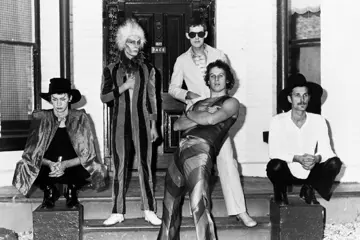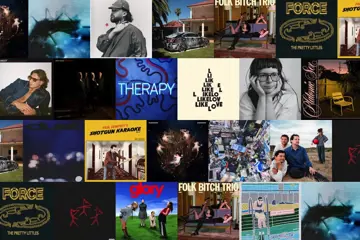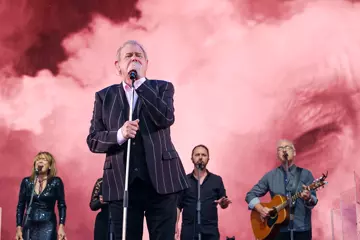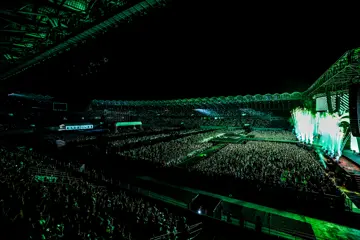Check out our gallery from the launch right here.
On Friday morning a small throng of fortunate journalists from all over the country were treated to an audience with venerated American auteur David Lynch, who was in Brisbane to give a public presentation at GoMA to open the new exhibition David Lynch: Between Two Worlds. It’s the first such exhibition of Lynch’s work to be staged in Australia, covering every medium that he’s worked in over his incredible 50-year career – including cinema, music, paintings, drawings, photography and television – all framed to consider the notion that wisdom is gained through knowledge and the experience of combined opposites.
The assembled media were ushered into a theatre and forced to wait 20 minutes with creepy music being piped in overlooking two empty seats on an unadorned stage – like some weird art installation in itself – before proceedings got underway and we were given spoken introductions by Queensland Art Gallery/Gallery of Modern Art (QAGOMA) Director Chris Saines and newly-elected Queensland Premier Annastasia Palaszczuk, who is also the new Minister for the Arts. It must be said that not only was Palaszczuk extremely articulate and personable in one of her first cultural outings as head of that latter portfolio, but she was also clearly knowledgeable about Lynch and art in general; after the way that this important area of culture was dismissed out of hand by the Newman regime it’s encouraging to have someone in charge who appreciates the import of art to a robust society.
Then the dapper and distinguished Lynch and exhibition curator José Da Silva (GoMA’s Senior Curator and Head of Australian Cinémathèque) took the seats on the stage and – after an initial barrage of photography as nearly everyone in attendance scrambled to get a picture of the great man on whatever appliance they had at their disposal – began looking firstly as Lynch’s life before working their way towards the exhibition itself. A brief notation of points covered includes;
- The scope of Lynch’s artistic vision going back to the mid-‘60s
- The exhibition title Between Two Worlds was taken from a poem that Lynch penned in the late-’80s while working on the pilot for his acclaimed TV series Twin Peaks.
- Reminiscences about Lynch’s childhood love of drawing, and how this flourished when his Mum refused to buy him colouring books. His main fortes at this point were drawing knifes, guns and airplanes.
- Painting quickly became his first artistic love
- Living in Philadelphia between 1965-70 (where he attended Pennsylvania Academy Of Fine Arts) the city itself became his biggest inspiration; he described it as “corrupt, fear-ridden and negative in atmosphere” and he loved this about it. The architecture and mood encouraged him to dream.
- He discussed his constant trope “the world is as you are” – your view of the world constantly changes and is usually contingent on how you yourself are faring inside at the time. This premise is something that he doesn’t tire of exploring.
At this juncture Da Silva opened the floor and the erudite and often inscrutable Lynch took questions from journalists and media (the contingent clearly containing many stringent admirers of the artist and his oeuvre). Points raised during this period included;
- He doesn’t consider his diversions into TV and cinema as a distraction from his beloved visual arts – “you go where the ideas lead you” Lynch explained concisely. He posited that ideas and love (two recurring motifs) drive the brain.
- “knowing thyself” isn’t about the mirror or the body, but looking within
- Lynch spoke highly of GoMA itself and Da Silva’s work and spoke gushingly about how fortunate the people of Brisbane are to have such a resource and high quality curators
- He described the practice of cutting art and music from school curriculums when cost-cutting measures were needed (which always occurs first) as “pathetic”
- Lynch described drawing as the easiest artistic discipline, but all are easy once you get an idea: “ideas drive everything”. He espoused that each medium is infinitely deep and that each is completely fascinating in and of itself
- He denied that his art was a way of sharing his dream with us – he hasn’t got many ideas from nighttime dreaming, but he loves daytime dreaming. He loves to sit in a chair and let ideas just come to him from the ether. He loves the idea of dream logic, which is abstract but still able to be understood.
- He would not be drawn on the future direction of Twin Peaks or why he chose to revisit the franchise at this time
- Lynch spoke animatedly and at length about his love of transcendental meditation. He’s been practicing the ancient mental technique twice daily for 41 years, and explains that it’s more about contemplation than concentration – it allows him to “dive within and experience an unbounded ocean of pure consciousness”. He describes it as an incredible experience which allows one to expand consciousness which in turn flows on to allow one to feel love, peace, happiness and intelligence while blocking out stress, anxiety, fear, anger, depression and other negativities which affect all life and relationships. He believes that people are fatigued by modern society and experience too much hate and negativity, and that “the Kingdom Of Heaven” lies within.
- He spoke about how graffiti has ruined the world, making it harder to find pure film sets. He believes that great architecture like train stations and factories are on the wane, and all been replaced by the scourge of graffiti
- He believes that Laura Palmer’s Theme is his favourite piece that he’s worked on with musical cohort Angelo Badalamenti – he believes it has an inherent beauty and cried the first time Badalamenti played it to him (which made Badalamenti nonplussed as he didn’t initially think it was anything special).
- He believes that Daoism is right on the money, and that derivations of the core principles can be found in most religions and cultures
- He fears for young people searching for beauty in the modern world; kids today don’t want to be told anything by adults, so we need to find a technique of “diving within themselves” on their own to energise and fulfill their desires and to unfold their full potential as human beings.
- He talked of “tremendous freedoms”, and how the myriad of restrictions in modern society are “horrible”. There are too many rules – for instance he’s been smoking since he was 5 years-old and now that freedom is being regulated almost out of existence. We need freedom, and diving within gives one “euphoric freedom”
- He loves things he acknowledges are strange – smoke, fire, machinery, oil-impregnated earth – but doesn’t know why
- He’s saddened by the gradual disappearance of smokestacks and big factories – modern facilities are efficient but they don’t have the “appearance of power”, which he finds depressing.
- He’s inspired by people’s behaviour and the absurdity of modern problems. People’s behaviour conjures ideas – we live in a world of opposites and exploring within allows oneness and unity.
Don't miss a beat with our FREE daily newsletter
At this point Lynch was given a standing ovation and left the theatre. He was well-spoken (albeit in a slightly clipped, almost terse manner) and ludicrously engaging, and his continual return to the tenets of “ideas” and “looking within one’s self” was fascinating where in lesser hands it may have been trite or hackneyed. The experience cast a while new light on his work, especially his body of cinematic and televisual art which can now be seen in context of his broader artistic vision and worldview.
Then we were given free rein to explore the exhibition itself, which also proved a fascinating exercise. It’s diverse in both substance and form but united by a singularity of vision – one which is resolutely weird, but in a questing rather than post-modern sense. Nothing is grouped chronologically or even thematically, instead three ideas underpin the disparate works which are spread across seven galleries;
- Man And Machine
- The extra-ordinary
- Psychic aches
Between Two Worlds runs until early-June, and also incorporates screenings, talks, music installations (by esteemed artists including Xiu Xiu, HEXA and Lawrence English), guided tours and even a Twin Peaks trivia night. For full details head to qagoma.qld.gov.au/davidlynch.















